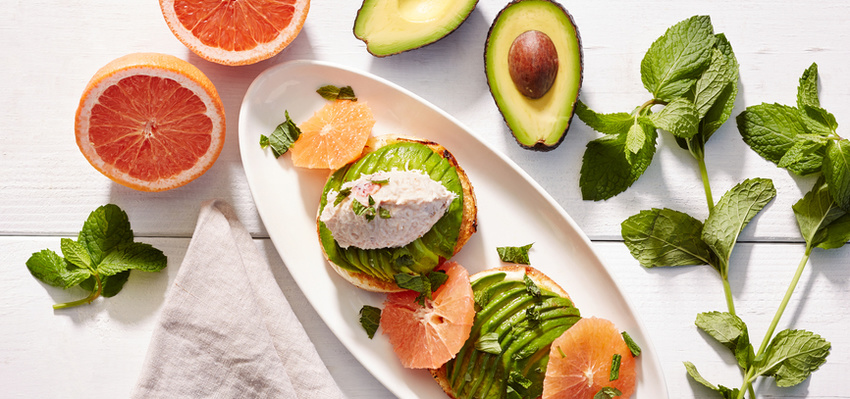Are you planning to sport that short, sparkly dress for New Year's Eve?
2015 is right around the corner, with holiday parties still in full swing before the clock strikes midnight on December 31st. Then, deep winter will settle in bringing frigid evenings begging for skinny jeans, leggings, stockings and cool thigh-high boots.
If you want to lengthen and tone your legs for these sexy looks, yoga is the answer. But not just any yoga — you need to practice poses that stretch your glutes, hip flexors, quads, adductors, abductors, hamstrings, calves and Achilles tendons.
If you get started now, there is plenty of time to slim down and tone up your legs, for any slender-fitting winter fashion.
Try this yoga sequence specifically designed for long, lean and sexy legs. Modifications are provided.
From Downward Dog, step your right foot forward into a low lunge.
Come into a balance on the right foot, elevating the left leg up and back and externally opening your left hip while keeping both legs straight.
Bring your torso in toward your right leg if possible, or just stay where you are comfortable.
In the modified variation, the legs will form more of an L-shape than a split.
You may keep both hands on the ground, or to intensify the stretch you can hold onto your right ankle with your right hand and pull yourself in toward your leg.
Hold for 10 breaths. Step back to Downward Dog and then switch sides.
Come into a kneeling position with your knees together and feet hips-width apart.
Sit back between your ankles onto the floor, a block or a blanket (you can use two blocks or fold up your blanket for extra modification).
Roll your thighs in and down. Stack your shoulders over your waist and sit tall.
Hold for two minutes and breathe deeply.
From hands and knees, bring your right knee toward the outer edge of your mat turning out at your hip. Slide your left leg straight back behind your hip, until it is straight.
If your hips are too tight to sit on the ground, use blocks or a blanket under your right sit bone to help prop yourself up and square off your hips.
Walk your forearms to the floor, keeping your spine long. Extend the arms straight and long in front of you if possible, and reset your forehead on the mat or on a block. Hold for two minutes.
Walk your hands back by your hips and hold for a few breaths. Switch sides.
Tip: The farther away the front heel is from the opposite hip, the deeper the stretch.
Come onto your hands and knees. Extend your right foot in front of you, balancing on your heel. Use blocks beneath your hands if you cannot touch the ground.
Pull your toes back toward your body (dorsiflexion).
Keep a long spine on the diagonal for a modification.
If you can maintain a long spine, begin to hinge at your right hip to fold over your right leg, aiming your face toward your shin.
From the upright Half-Hanumanasana position, slide your right foot forward and lower your hip structure toward the mat.
To modify here, you will need to place 1-2 blocks underyour right sit bone for support.
If you feel more flexible, lower your props until you can assume a full split position on the ground.
Hold here for a few deep breaths and when you're ready to exit the pose, swing your back leg out in front of you as you shift your weight to the front hip. Switch sides.
2015 is right around the corner, with holiday parties still in full swing before the clock strikes midnight on December 31st. Then, deep winter will settle in bringing frigid evenings begging for skinny jeans, leggings, stockings and cool thigh-high boots.
If you want to lengthen and tone your legs for these sexy looks, yoga is the answer. But not just any yoga — you need to practice poses that stretch your glutes, hip flexors, quads, adductors, abductors, hamstrings, calves and Achilles tendons.
If you get started now, there is plenty of time to slim down and tone up your legs, for any slender-fitting winter fashion.
Try this yoga sequence specifically designed for long, lean and sexy legs. Modifications are provided.
Triangle Pose (Trikonasana)
Triangle Pose stretches the adductors of front and back legs.
Stand with your legs about three to three-and-a-half feet apart.
Pivot your right foot out 90 degrees and your left foot inward at about 35 degrees.
Place your hands on your hips and shift your hips toward your back heel while your right shoulder begins to descend toward your right leg.
Imagine that your back is touching a wall so that your torso is in line with your legs. Open your arms by placing your right hand onto your shin, a block, your ankle or your toe, while you extend the left arm above the right to form a straight line. Open across your chest.
Try to get the top and bottom of your torso to be parallel (no curves). This requires softening the top ribs down and in.
Hold for 10 deep breaths. Come back to a stand. Switch sides.
Stand with your legs about three to three-and-a-half feet apart.
Pivot your right foot out 90 degrees and your left foot inward at about 35 degrees.
Place your hands on your hips and shift your hips toward your back heel while your right shoulder begins to descend toward your right leg.
Imagine that your back is touching a wall so that your torso is in line with your legs. Open your arms by placing your right hand onto your shin, a block, your ankle or your toe, while you extend the left arm above the right to form a straight line. Open across your chest.
Try to get the top and bottom of your torso to be parallel (no curves). This requires softening the top ribs down and in.
Hold for 10 deep breaths. Come back to a stand. Switch sides.
Side Stretch Pose (Parsvottanasana)
This intense pose stretches and lengthens the shin, calves, hamstrings and glutes.
From Mountain Pose, step your left foot behind you about two-and-a-half feet, turning the foot out to 45 degrees.
Take your arms into prayer behind your back if possible. If prayer is not available, keep your arms along the side your body.
Hinge at your right hip until you assume a long spine parallel to the ground. Your hands will be in prayer behind your back, or you can place them onto your shins to modify.
Stay here or if you can, and fold deeper to bring your abdomen to touch your thigh and your face toward your shin.
Hold for 10 deep breaths. Switch sides.
From Mountain Pose, step your left foot behind you about two-and-a-half feet, turning the foot out to 45 degrees.
Take your arms into prayer behind your back if possible. If prayer is not available, keep your arms along the side your body.
Hinge at your right hip until you assume a long spine parallel to the ground. Your hands will be in prayer behind your back, or you can place them onto your shins to modify.
Stay here or if you can, and fold deeper to bring your abdomen to touch your thigh and your face toward your shin.
Hold for 10 deep breaths. Switch sides.
Forward Fold (Uttanasana)
Uttanasana stretches the Achilles, calves, hamstrings and glutes.
Stand with your feet hips-width apart. Fold forward, hinging at your hips and placing your palms on the ground beside your pinky toes.
If you're hamstrings are tight and you can't touch the ground, bend your knees to modify this posture and just let your hands hang evenly along side your shins.
Hold for 10 deep breaths as you keep the head and neck soft and released.
Stand with your feet hips-width apart. Fold forward, hinging at your hips and placing your palms on the ground beside your pinky toes.
If you're hamstrings are tight and you can't touch the ground, bend your knees to modify this posture and just let your hands hang evenly along side your shins.
Hold for 10 deep breaths as you keep the head and neck soft and released.
Dancer's Pose (Natarajasana)
Dancer's Pose stretches the hamstrings of the front leg and the quads and hip flexors of back leg.
From Mountain Pose, bend your right knee so that you can grab your inner ankle with your hand, palm facing open. Make sure your arm doesn't twist; this is an external rotation of the shoulder.
If you have trouble with standing balances, to modify, go to a wall and begin in Mountain Pose facing the wall, so that you can support yourself with your extended palm once you enter the pose.
Draw your core inward and up, keeping it engaged for the duration of the pose. Focus your gaze on a single point, keeping it soft.
As you inhale, raise your left arm straight out and up along your ear, raising your right leg up and back behind you allowing your spine to back bend into a half moon shape.
If you are using the wall, the left hand supports you on the wall.
Keep your chest lifted as your leg elevates. Hold for 5 breaths. Switch sides
From Mountain Pose, bend your right knee so that you can grab your inner ankle with your hand, palm facing open. Make sure your arm doesn't twist; this is an external rotation of the shoulder.
If you have trouble with standing balances, to modify, go to a wall and begin in Mountain Pose facing the wall, so that you can support yourself with your extended palm once you enter the pose.
Draw your core inward and up, keeping it engaged for the duration of the pose. Focus your gaze on a single point, keeping it soft.
As you inhale, raise your left arm straight out and up along your ear, raising your right leg up and back behind you allowing your spine to back bend into a half moon shape.
If you are using the wall, the left hand supports you on the wall.
Keep your chest lifted as your leg elevates. Hold for 5 breaths. Switch sides
Short Downward Dog (Adho Mukha Svanasana)
This slightly modified Down Dog stretches the Achilles, calves, hamstrings and glutes.
Come onto your hands and knees. Walk your hands forward about six inches in front of your shoulders.
Place your hands shoulder distance apart, knees hips-width. Spread your fingers wide. Press firmly into your hands so that you can lift your knees off the floor while floating your hips up and away from your hands.
Assume an upside down V-shaped position with equal weight distribution on your hands and feet. If your spine rounds and your weight doesn't feel evenly distributed, bend your knees to modify.
Over time, work toward getting both heels on the ground (or straightening your legs with your heels slightly off the ground).
Hold for 10 deep breaths.
Come onto your hands and knees. Walk your hands forward about six inches in front of your shoulders.
Place your hands shoulder distance apart, knees hips-width. Spread your fingers wide. Press firmly into your hands so that you can lift your knees off the floor while floating your hips up and away from your hands.
Assume an upside down V-shaped position with equal weight distribution on your hands and feet. If your spine rounds and your weight doesn't feel evenly distributed, bend your knees to modify.
Over time, work toward getting both heels on the ground (or straightening your legs with your heels slightly off the ground).
Hold for 10 deep breaths.
Standing Split (Urdhva Prasarita Eka Padasana)
Standing Split stretches the entire back of the grounded leg out nice and long, as well as the hip flexor, inner groins and adductors of the elevated leg.
From Downward Dog, step your right foot forward into a low lunge.
Come into a balance on the right foot, elevating the left leg up and back and externally opening your left hip while keeping both legs straight.
Bring your torso in toward your right leg if possible, or just stay where you are comfortable.
In the modified variation, the legs will form more of an L-shape than a split.
You may keep both hands on the ground, or to intensify the stretch you can hold onto your right ankle with your right hand and pull yourself in toward your leg.
Hold for 10 breaths. Step back to Downward Dog and then switch sides.
Hero Pose (Virasana)
Hero Pose stretches the quads, shins, tops of the feet and the soft tissue around the knees.
Come into a kneeling position with your knees together and feet hips-width apart.
Sit back between your ankles onto the floor, a block or a blanket (you can use two blocks or fold up your blanket for extra modification).
Roll your thighs in and down. Stack your shoulders over your waist and sit tall.
Hold for two minutes and breathe deeply.
Pigeon Pose (Eka Pada Rajakapotasana)
Pigeon Pose stretches the abductors of front leg, the IT band, the quads and hip flexors, the shin and the top of the foot of the back leg.
From hands and knees, bring your right knee toward the outer edge of your mat turning out at your hip. Slide your left leg straight back behind your hip, until it is straight.
If your hips are too tight to sit on the ground, use blocks or a blanket under your right sit bone to help prop yourself up and square off your hips.
Walk your forearms to the floor, keeping your spine long. Extend the arms straight and long in front of you if possible, and reset your forehead on the mat or on a block. Hold for two minutes.
Walk your hands back by your hips and hold for a few breaths. Switch sides.
Tip: The farther away the front heel is from the opposite hip, the deeper the stretch.
Runner's Stretch (Half-Hanuman)
This modified version of full Hanumanasana will stretch the Achilles, calves hamstrings and glutes of front leg.
Come onto your hands and knees. Extend your right foot in front of you, balancing on your heel. Use blocks beneath your hands if you cannot touch the ground.
Pull your toes back toward your body (dorsiflexion).
Keep a long spine on the diagonal for a modification.
If you can maintain a long spine, begin to hinge at your right hip to fold over your right leg, aiming your face toward your shin.
Hanuman Splits (Hanumanasana)
Hanumanasana stretches the Achilles, calves hamstrings and glutes of front leg, and the hip flexor, quad, shin, and the top of the foot of back leg.
From the upright Half-Hanumanasana position, slide your right foot forward and lower your hip structure toward the mat.
To modify here, you will need to place 1-2 blocks underyour right sit bone for support.
If you feel more flexible, lower your props until you can assume a full split position on the ground.
Hold here for a few deep breaths and when you're ready to exit the pose, swing your back leg out in front of you as you shift your weight to the front hip. Switch sides.
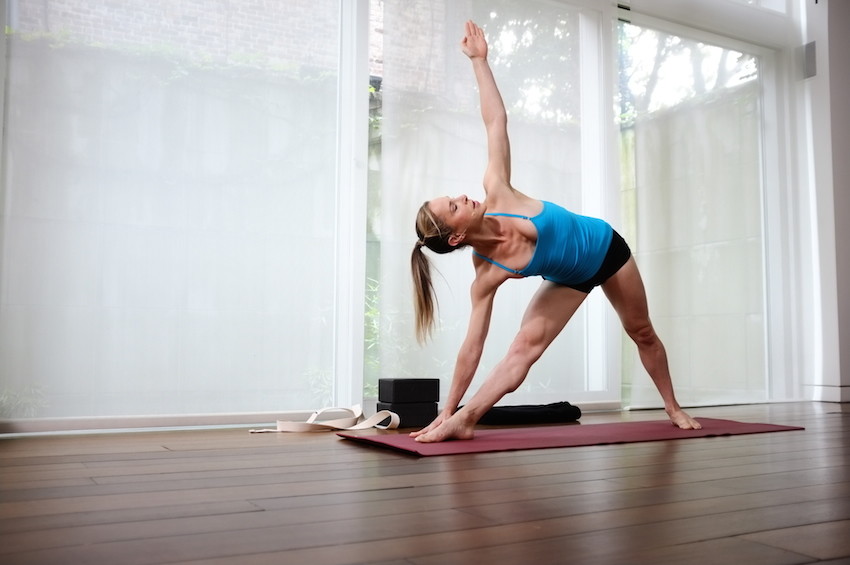
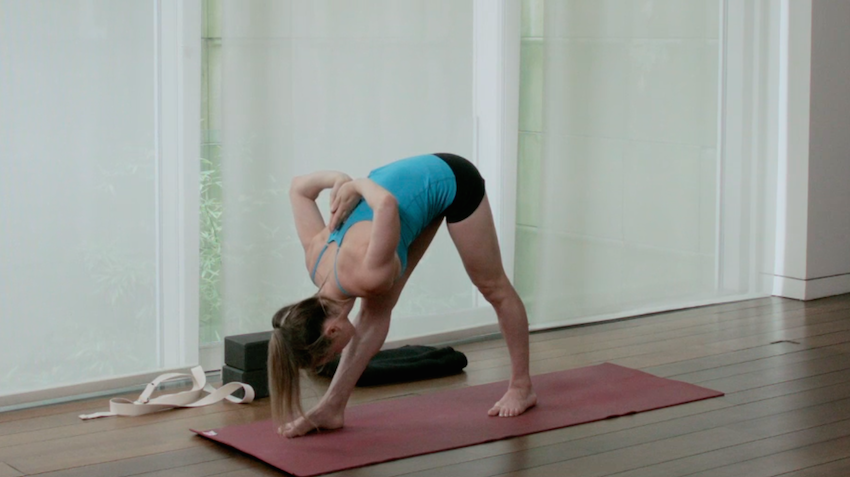
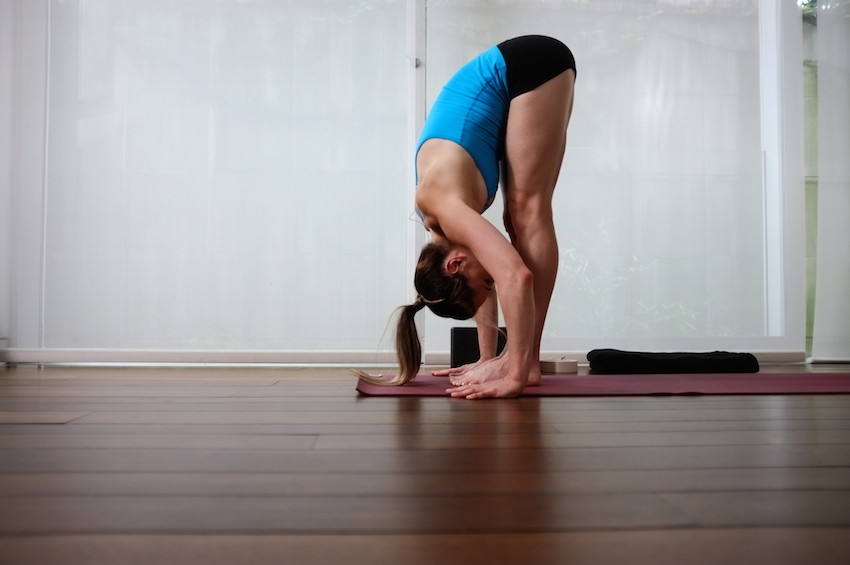
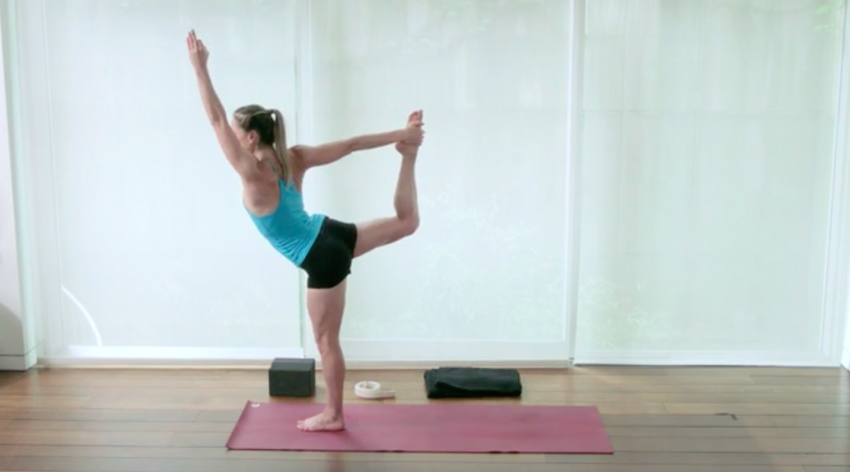
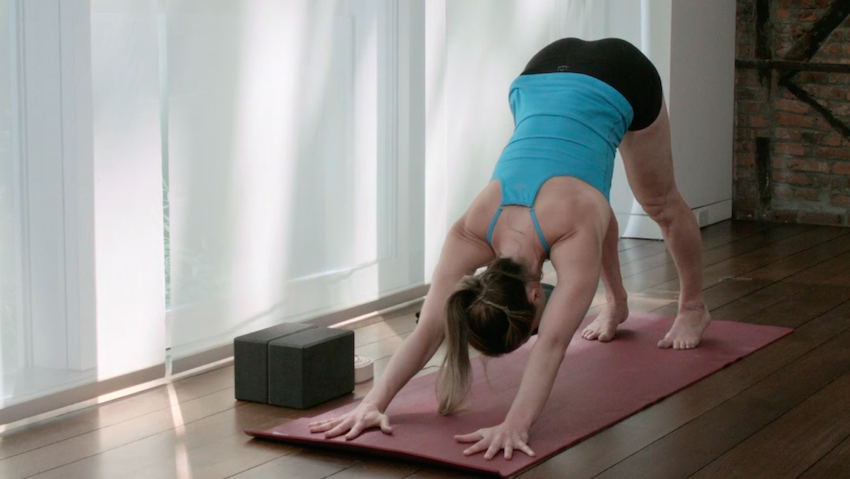
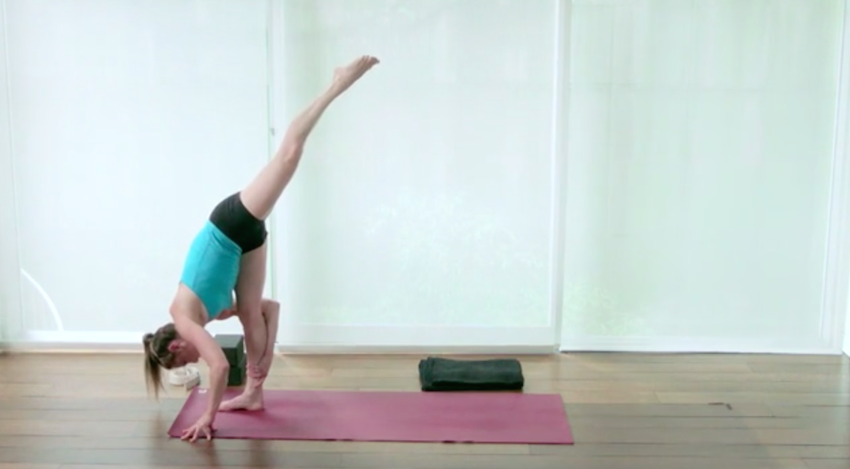
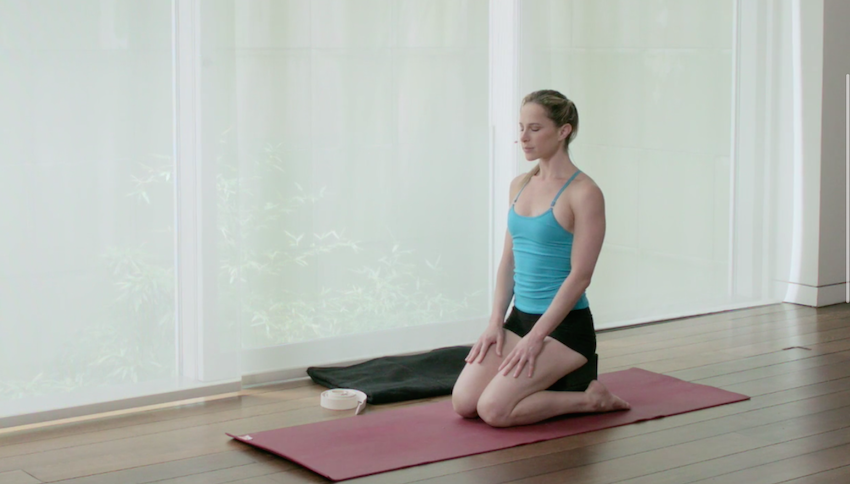
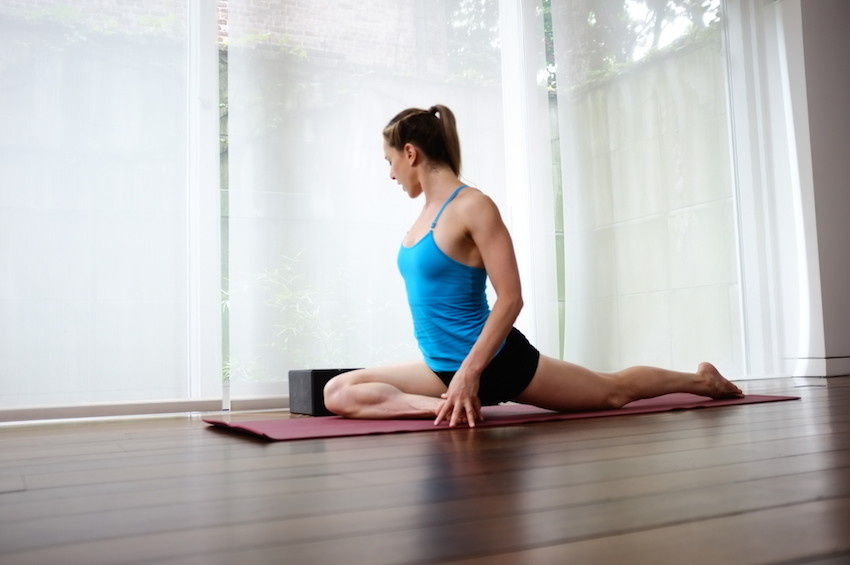
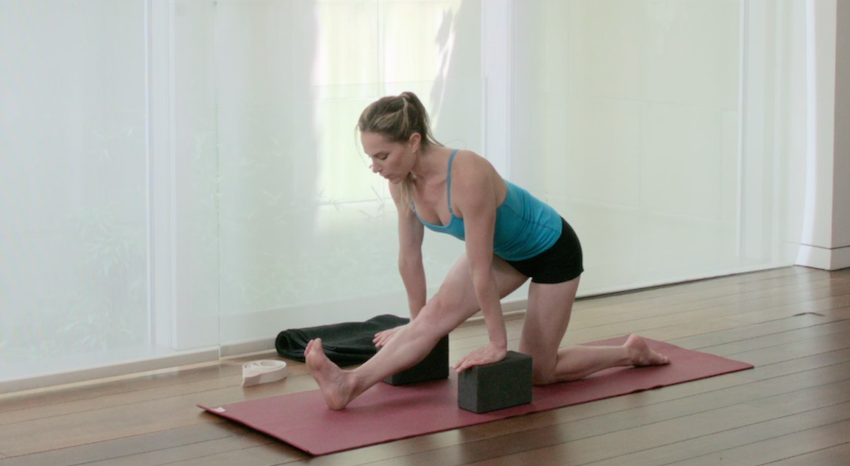
.JPG)

